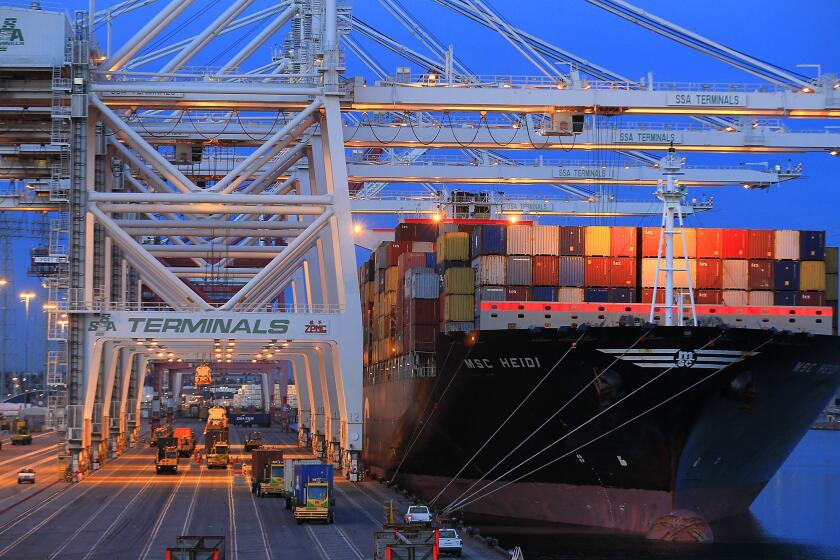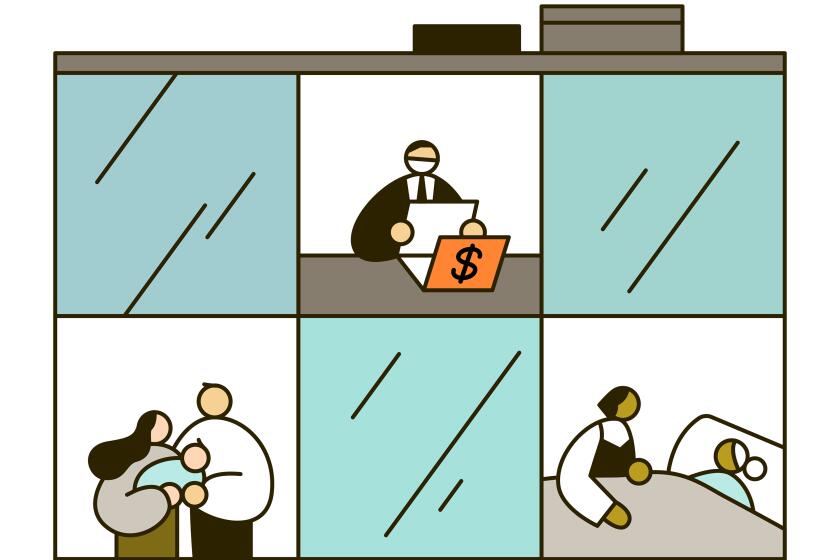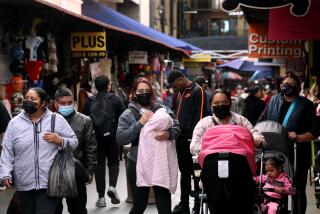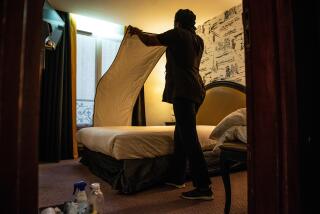A ‘full reverse’: California joblessness spiked in December, thwarting recovery

California’s unemployment rate surged in December as the COVID-19 pandemic spun out of control and more businesses were forced to shut down, reversing a months-long economic recovery.
Nine percent of Californians counted themselves out of work in December, up from 8.1% in November, state officials reported. It was the first monthly rise since April’s unprecedented 16.4% jobless rate.
Much of the distress was driven by hotels and restaurants closing, as tourism and business travel failed to revive and officials restricted dining out to try to control the spread of the virus. The leisure and hospitality sector lost 117,000 payroll jobs, offsetting gains in construction and professional and business services.
“December’s job loss capped a year of trauma,” said Lynn Reaser, an economist at Point Loma Nazarene University in San Diego. “Summer should usher in a stronger economy, but it will be critical to first subdue the virus. Only then can we spring back to life.”
COVID-19 has sickened more than 3 million Californians since the spring, killing more than 35,800, according to a Times tracker. So far, just 1.6 million vaccines have been administered amid shortages and a rocky rollout.
The virus surged after Thanksgiving, as many Americans ignored warnings to avoid traveling and gathering with friends and relatives over the holiday. At the same time, businesses ran out of federal loans, unemployment benefits expired and Congress remained stalemated over a new coronavirus rescue package.
A Covid-19 surge at the ports of Los Angeles and Long Beach has sickened hundreds of longshore workers, a disruption that could stymie the flow of goods - including pandemic supplies - through the nation’s largest port complex. Port and local officials are calling for urgent vaccination of dockworkers.
A $908-billion aid bill was signed Dec. 28, which will grant $300 a week in federal unemployment benefits in addition to regular state aid, and allow businesses to apply for new federal Paycheck Protection Program loans.
Many economists predict the new package will be far from adequate to address the crisis. President Biden has proposed an additional $1.9-trillion stimulus plan to combat the coronavirus emergency, but it faces a divided Congress.
California’s labor market is faring worse than the nation’s, as the state has become a virus hot spot. U.S. unemployment was 6.7% in December. Between December 2019 and last month, California payrolls were down by 1.41 million jobs, an 8% drop. During the same period, the U.S. lost 9.37 million jobs, a 6.2% decrease.
“The full reverse in California’s recovery in December was largely responsible for the poor national job performance last month,” said Scott Anderson, chief economist of the Bank of the West in San Francisco. California’s net 52,000 job decline accounted for 37% of the 140,000-job loss across the U.S. in December.
The Golden State has regained just 44% of the 2.6 million jobs it lost in March and April when the coronavirus began to grip the nation — in contrast with the return of 55.6% of U.S. payroll positions.
Laws taking effect in 2021 will make California businesses offer employees more help to cope with the COVID-19 pandemic. Other topics include gig workers, minimum wage, and diversity on corporate boards.
“California’s recovery will continue to lag the nation’s as long as the pandemic rages,” Anderson said, predicting it will take until the second half of this year before widespread vaccinations and pent-up demand restore confidence.
A sharp contrast between sectors that have shed jobs and those with stable or expanding payrolls highlights the social inequality exacerbated by the virus. Leisure and hospitality jobs, which have plummeted 30% this year, are held by “some of the most vulnerable workers in the economy,” said Pomona College economist Fernando Lozano.
“Almost half of them do not have more than a high school degree. Workers in this sector are also more likely to be women, be Black or Latino, or be foreign-born,” he said.
The uneven recovery, he said, has meant that “employment for workers with a college education is at the same level as when the pandemic started. People with less than a college degree have lost more than a million jobs in California alone.”
The trend was also reflected in the loss of 11,000 jobs last month in the “other services” sector, which includes hairdressers and nail salons, occupations with large numbers of low-wage immigrant workers.
California’s accountants and bookkeepers along with scientific and technical consultants were among the winners in December as the professional and business services sector gained 29,600 jobs.
Jobs for plumbers, electricians and painters also soared as construction payrolls gained 31,600 positions. Home-bound workers have upgraded their living and working quarters, rather than travel or dine out.
One closely watched indicator, the size of the state’s labor force, which includes both workers and job seekers, seemed to offer some positive news last month. It grew by a modest 72,000, but economists said that may have reflected a return to the job hunt by people growing desperate as jobless benefits dried up.
The labor force is still “a whopping 523,300 below a year ago,” said Sung Won Sohn, a Loyola Marymount University economist. “Many people have given up looking for work. They’re caring for children and the elderly at home. Young people have flocked to graduate schools to learn new skills. But some dropouts will never come back and that will hurt the state’s future growth.”
California’s unequal recovery was reflected in vast regional differences. Unadjusted jobless rates in December ranged from 5.5% in Marin County, a refuge of wealthy technology executives, to 17.7% in Imperial County, which has thousands of farmworkers who have suffered outsized COVID-19 infection rates.
Los Angeles County’s seasonally adjusted jobless rate was 11% in December, up a notch from 10.9% in November. County payrolls shrank to 4,234,900 with the loss of 23,900 jobs. As in the state at large, the leisure and hospitality sector bore the biggest brunt, with restaurants and bars accounting for most of the loss.
Large layoff notices filed with the state employment development department included 103 workers furloughed from the Intercontinental Hotel in downtown Los Angeles and 411 jobs permanently shed by Larry Flynt’s Hustler Casino in Gardena.
Orange County’s unadjusted jobless rate was 7.4% in December, up from 6.4% in November. Payrolls dropped to 1,553,000, a decline of 8,100 jobs.
In the Inland Empire, which spans Riverside and San Bernardino counties, the unadjusted jobless rate was 9.1% in December, up from 7.9% the month before. The region’s payrolls shrank by 3,300 jobs, to 1,459,600.
December’s unemployment data are taken from two federal surveys during the week of Dec. 12. The unemployment rate is based on a survey of 5,100 California households. The payroll job numbers come from a survey of 80,000 California businesses.









